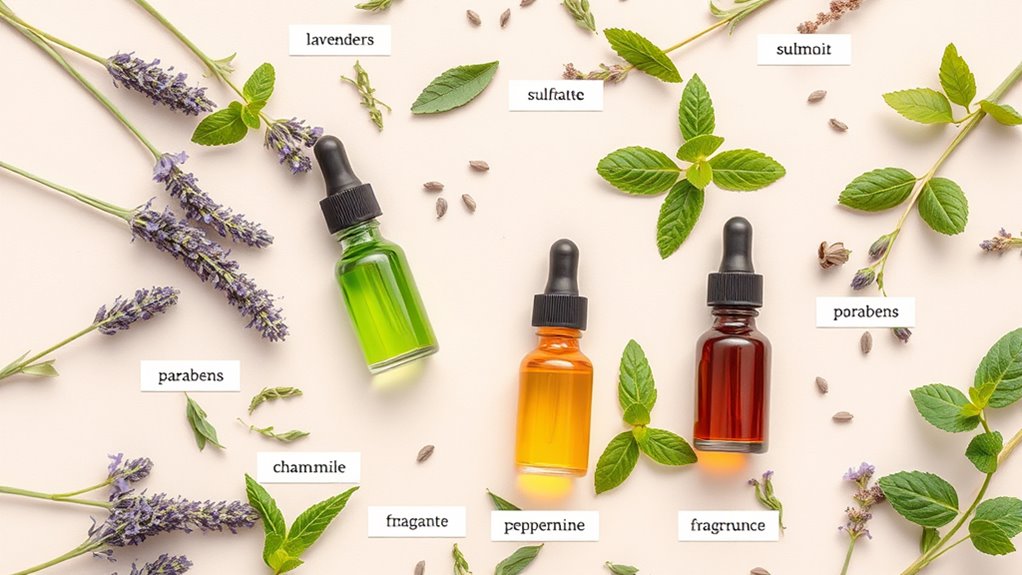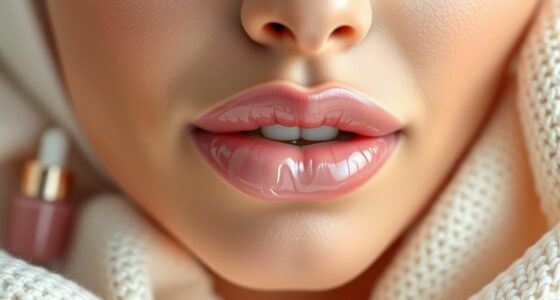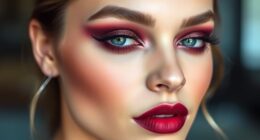To keep your beauty routine clean and non-toxic, avoid ingredients like parabens, formaldehyde-releasing preservatives, triclosan, sulfates, and phthalates. These chemicals can disrupt hormones, damage your skin barrier, and pose long-term health risks. Look for products with natural preservatives, fragrance-free options, and transparent ingredient lists. By choosing safer alternatives, you support healthier skin and overall well-being. If you continue exploring, you’ll find even more ways to make informed, toxin-free choices.
Key Takeaways
- Avoid parabens, formaldehyde-releasing preservatives, and triclosan to prevent hormone disruption and carcinogenic risks.
- Choose fragrance-free or natural scent products to reduce exposure to endocrine-disrupting phthalates.
- Use sulfate-free cleansers to protect skin barrier integrity and prevent dryness or irritation.
- Steer clear of products with ambiguous dyes or coal tar derivatives that may contain carcinogenic contaminants.
- Prioritize transparent labels and natural ingredients to minimize exposure to harmful chemicals and support safer skincare.

Have you ever wondered what’s really in your beauty products? Many conventional products contain ingredients that might do more harm than good. This concern has led to a surge in natural skincare options, emphasizing ingredient safety and transparency. When you choose clean and non-toxic beauty, you’re prioritizing products free from harmful chemicals, which means paying close attention to the ingredients list. Understanding what to avoid is key to making smarter choices for your skin and overall health.
Start by steering clear of parabens. These preservatives are commonly used to extend shelf life, but research suggests they can mimic hormones and disrupt your endocrine system. Long-term exposure might even increase the risk of certain cancers. Similarly, phthalates—often found in fragrances—are linked to hormonal imbalances and reproductive issues. Since fragrances are usually listed as “fragrance” or “parfum” without specifics, it’s wise to choose products labeled fragrance-free or made with natural scent ingredients to reduce exposure.
Avoid parabens and phthalates to protect your hormonal health and reduce cancer risk.
Another ingredient to avoid is formaldehyde-releasing preservatives, such as quaternium-15, DMDM hydantoin, and imidazolidinyl urea. These chemicals slowly release formaldehyde, a known carcinogen. They’re added to many skincare and haircare products to prevent bacterial growth, but their presence compromises ingredient safety. Instead, look for products that use natural preservatives like vitamin E or certain plant-based options.
Sulfates, like sodium lauryl sulfate (SLS) and sodium laureth sulfate (SLES), are common foaming agents that can strip your skin of its natural oils. This leads to dryness, irritation, and even damage to the skin barrier, especially for sensitive skin types. Choosing sulfate-free cleansers supports natural skincare routines that maintain your skin’s moisture and resilience.
Lastly, avoid ingredients with ambiguous or potentially harmful names, such as triclosan, which is an antibacterial agent linked to hormone disruption and antibiotic resistance. Also, be wary of certain dyes and colorants derived from coal tar, which can contain carcinogenic contaminants. Opt for products with clearly listed, natural colorants or those without added dyes.
Frequently Asked Questions
Are Natural Ingredients Always Safe for My Skin?
Natural ingredients aren’t always safe for your skin, even though many believe they are inherently better. Natural misconceptions can lead you to assume all plant-based or organic ingredients are harmless, but some may cause allergic reactions or irritation. Always check ingredient safety, do patch tests, and consult with skincare professionals. Remember, just because something is natural doesn’t guarantee it’s suitable or safe for your skin type.
How Can I Identify Hidden Toxins in Beauty Products?
You can identify hidden toxins in beauty products by carefully reading ingredient labels and researching ingredient sources. Look out for unfamiliar or long, complicated names that might hide harmful chemicals. Use apps or online resources to verify ingredients and their safety. Trust brands committed to transparency and clean formulations. Staying informed helps you make smarter choices and avoid potential toxins lurking in seemingly safe products.
Do Organic Products Guarantee Non-Toxic Ingredients?
Imagine choosing an organic lipstick labeled with organic certification; it seems safer, but that doesn’t guarantee non-toxic ingredients. Organic certification primarily confirms farming practices, not ingredient safety. You need ingredient transparency to verify there are no hidden toxins. Always read labels carefully, and trust brands that openly disclose every ingredient, so you can truly avoid harmful substances, even in products marketed as organic.
Are There Any Side Effects From Using Non-Toxic Beauty Products?
Using non-toxic beauty products generally reduces your risk of side effects, but allergic reactions can still occur if you have sensitivities to certain ingredients. Some products may also cause hormone disruption if they contain certain chemicals, though these are less common in truly non-toxic options. Always check ingredients and do a patch test to avoid unwanted side effects, and consult a dermatologist if you experience any adverse reactions.
How Often Should I Switch to Clean Beauty Brands?
You should switch to clean beauty brands every 6 to 12 months to guarantee ideal product longevity and freshness. Regular brand switching helps you discover new products that suit your skin better and prevents ingredient buildup. Pay attention to expiration dates and how your skin reacts. Staying updated with clean brands also means you’re reducing exposure to potentially harmful ingredients, keeping your skincare routine safe and effective.
Conclusion
Choosing clean, non-toxic beauty is like planting a garden—you nurture it with safe, nourishing ingredients, and it blossoms into your best self. Once, I swapped out a toxic lipstick for a natural one, and my skin thanked me with a clear, radiant glow. Remember, every ingredient you avoid is a weed pulled from your garden. By making mindful choices, you cultivate beauty that’s healthy, vibrant, and toxin-free—your personal oasis of confidence.









